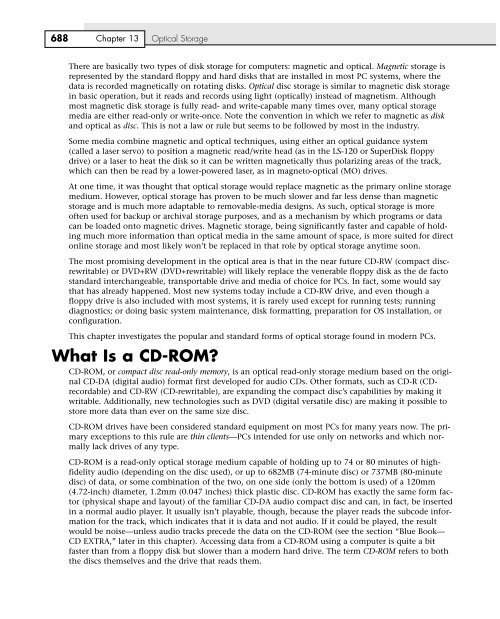You also want an ePaper? Increase the reach of your titles
YUMPU automatically turns print PDFs into web optimized ePapers that Google loves.
688 Chapter <strong>13</strong> Optical Storage<br />
There are basically two types of disk storage for computers: magnetic and optical. Magnetic storage is<br />
represented by the standard floppy and hard disks that are installed in most PC systems, where the<br />
data is recorded magnetically on rotating disks. Optical disc storage is similar to magnetic disk storage<br />
in basic operation, but it reads and records using light (optically) instead of magnetism. Although<br />
most magnetic disk storage is fully read- and write-capable many times over, many optical storage<br />
media are either read-only or write-once. Note the convention in which we refer to magnetic as disk<br />
and optical as disc. This is not a law or rule but seems to be followed by most in the industry.<br />
Some media combine magnetic and optical techniques, using either an optical guidance system<br />
(called a laser servo) to position a magnetic read/write head (as in the LS-120 or SuperDisk floppy<br />
drive) or a laser to heat the disk so it can be written magnetically thus polarizing areas of the track,<br />
which can then be read by a lower-powered laser, as in magneto-optical (MO) drives.<br />
At one time, it was thought that optical storage would replace magnetic as the primary online storage<br />
medium. However, optical storage has proven to be much slower and far less dense than magnetic<br />
storage and is much more adaptable to removable-media designs. As such, optical storage is more<br />
often used for backup or archival storage purposes, and as a mechanism by which programs or data<br />
can be loaded onto magnetic drives. Magnetic storage, being significantly faster and capable of holding<br />
much more information than optical media in the same amount of space, is more suited for direct<br />
online storage and most likely won’t be replaced in that role by optical storage anytime soon.<br />
The most promising development in the optical area is that in the near future CD-RW (compact discrewritable)<br />
or DVD+RW (DVD+rewritable) will likely replace the venerable floppy disk as the de facto<br />
standard interchangeable, transportable drive and media of choice for PCs. In fact, some would say<br />
that has already happened. Most new systems today include a CD-RW drive, and even though a<br />
floppy drive is also included with most systems, it is rarely used except for running tests; running<br />
diagnostics; or doing basic system maintenance, disk formatting, preparation for OS installation, or<br />
configuration.<br />
This chapter investigates the popular and standard forms of optical storage found in modern PCs.<br />
What Is a CD-ROM?<br />
CD-ROM, or compact disc read-only memory, is an optical read-only storage medium based on the original<br />
CD-DA (digital audio) format first developed for audio CDs. Other formats, such as CD-R (CDrecordable)<br />
and CD-RW (CD-rewritable), are expanding the compact disc’s capabilities by making it<br />
writable. Additionally, new technologies such as DVD (digital versatile disc) are making it possible to<br />
store more data than ever on the same size disc.<br />
CD-ROM drives have been considered standard equipment on most PCs for many years now. The primary<br />
exceptions to this rule are thin clients—PCs intended for use only on networks and which normally<br />
lack drives of any type.<br />
CD-ROM is a read-only optical storage medium capable of holding up to 74 or 80 minutes of highfidelity<br />
audio (depending on the disc used), or up to 682MB (74-minute disc) or 737MB (80-minute<br />
disc) of data, or some combination of the two, on one side (only the bottom is used) of a 120mm<br />
(4.72-inch) diameter, 1.2mm (0.047 inches) thick plastic disc. CD-ROM has exactly the same form factor<br />
(physical shape and layout) of the familiar CD-DA audio compact disc and can, in fact, be inserted<br />
in a normal audio player. It usually isn’t playable, though, because the player reads the subcode information<br />
for the track, which indicates that it is data and not audio. If it could be played, the result<br />
would be noise—unless audio tracks precede the data on the CD-ROM (see the section “Blue Book—<br />
CD EXTRA,” later in this chapter). Accessing data from a CD-ROM using a computer is quite a bit<br />
faster than from a floppy disk but slower than a modern hard drive. The term CD-ROM refers to both<br />
the discs themselves and the drive that reads them.
















